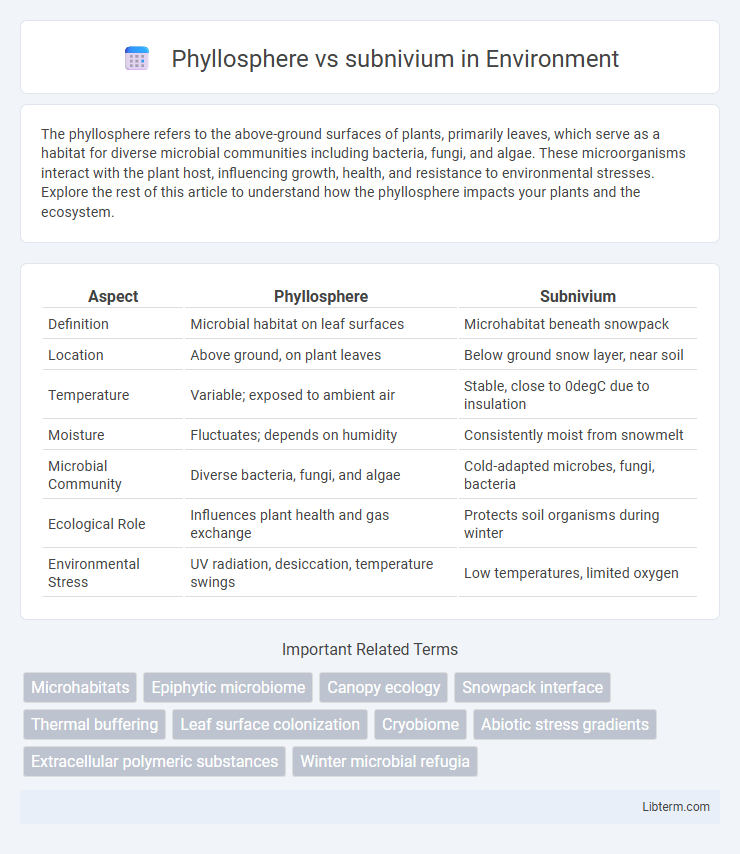The phyllosphere refers to the above-ground surfaces of plants, primarily leaves, which serve as a habitat for diverse microbial communities including bacteria, fungi, and algae. These microorganisms interact with the plant host, influencing growth, health, and resistance to environmental stresses. Explore the rest of this article to understand how the phyllosphere impacts your plants and the ecosystem.
Table of Comparison
| Aspect | Phyllosphere | Subnivium |
|---|---|---|
| Definition | Microbial habitat on leaf surfaces | Microhabitat beneath snowpack |
| Location | Above ground, on plant leaves | Below ground snow layer, near soil |
| Temperature | Variable; exposed to ambient air | Stable, close to 0degC due to insulation |
| Moisture | Fluctuates; depends on humidity | Consistently moist from snowmelt |
| Microbial Community | Diverse bacteria, fungi, and algae | Cold-adapted microbes, fungi, bacteria |
| Ecological Role | Influences plant health and gas exchange | Protects soil organisms during winter |
| Environmental Stress | UV radiation, desiccation, temperature swings | Low temperatures, limited oxygen |
Introduction to the Phyllosphere and Subnivium
The phyllosphere refers to the aerial surfaces of plants, particularly the leaves, serving as a critical habitat for diverse microbial communities that influence plant health and ecosystem functions. The subnivium is the transitional zone beneath the snowpack and above the soil, providing a stable, insulated environment crucial for overwintering organisms and microbial activity during cold seasons. Both the phyllosphere and subnivium represent unique ecological niches with distinct physical and biological characteristics that contribute to the maintenance of biodiversity and biogeochemical cycles.
Defining the Phyllosphere: An Aerial Habitat
The phyllosphere refers to the aerial surfaces of plants, primarily leaves, serving as a dynamic habitat for diverse microbial communities including bacteria, fungi, and algae. This ecological niche plays a crucial role in plant health and ecosystem function by influencing nutrient cycles, pathogen resistance, and atmospheric interactions. Unlike the subnivium, which is the environment beneath snow cover providing insulation for soil biota, the phyllosphere is exposed to fluctuating environmental conditions such as UV radiation, temperature changes, and moisture variability.
Understanding the Subnivium: Life Beneath the Snow
The subnivium is a critical microhabitat created between the soil surface and the insulating snowpack, providing stable, warmer temperatures essential for overwintering invertebrates and microbial communities. Unlike the phyllosphere, which encompasses microbial life on above-ground plant surfaces exposed to fluctuating environmental conditions, the subnivium offers protection from extreme cold and desiccation, fostering unique ecological interactions. Research on the subnivium enhances understanding of how below-snow environments support biodiversity and influence nutrient cycling during winter months.
Microbial Communities: Phyllosphere vs. Subnivium
Microbial communities in the phyllosphere, the above-ground surfaces of plants, exhibit high diversity and dynamic interactions influenced by sunlight, temperature fluctuations, and nutrient availability, promoting bacterial and fungal colonization critical for plant health. In contrast, the subnivium, the microenvironment beneath snow cover, fosters microbial populations adapted to cold, stable temperatures with low light, supporting psychrophilic and cryophilic bacteria and fungi that contribute to nutrient cycling during winter. These contrasting environments highlight significant differences in microbial diversity, resilience, and ecological functions essential for ecosystem balance across seasonal transitions.
Environmental Factors Influencing Each Habitat
The phyllosphere, the above-ground surfaces of plants, is influenced by factors such as temperature fluctuations, UV radiation, humidity, and air pollutants, which affect microbial community dynamics and plant health. In contrast, the subnivium, the insulating layer of soil beneath snow, experiences stable low temperatures, high moisture retention, reduced UV exposure, and limited gas exchange, creating a unique microhabitat for overwintering organisms. Variations in snow cover duration and thickness critically shape subnivium conditions, while plant species diversity and canopy architecture primarily impact the phyllosphere environment.
Seasonal Dynamics in Both Ecosystems
Seasonal dynamics in the phyllosphere involve fluctuations in microbial communities driven by changes in leaf surface conditions, temperature, and humidity throughout the growing season. In contrast, the subnivium, a microhabitat beneath the snowpack, exhibits more stable temperatures but seasonal shifts in moisture and organic matter availability influence microbial activity during winter and spring thaw. Both ecosystems play crucial roles in nutrient cycling, with the phyllosphere responding rapidly to seasonal plant phenology and the subnivium buffering microbial processes against extreme cold.
Ecological Roles and Functions
Phyllosphere hosts diverse microbial communities that influence plant health by modulating nutrient cycling, pathogen resistance, and stress tolerance in terrestrial ecosystems. Subnivium provides a stable, insulated microhabitat beneath the snowpack, crucial for overwintering invertebrates, seed germination, and microbial activity in cold climates. Both niches play vital roles in ecosystem functioning by supporting biodiversity and facilitating biogeochemical processes under distinct environmental conditions.
Adaptation Strategies of Organisms
Organisms in the phyllosphere exhibit adaptations such as biofilm formation and UV protection to survive exposure to fluctuating temperature and moisture on leaf surfaces. In contrast, subnivium inhabitants adapt by developing antifreeze proteins and metabolic rate depression, enabling survival under stable, cold, and insulated snowpack conditions. These distinct strategies reflect evolutionary responses to the contrasting microclimates and resource availability in aerial versus subnivean habitats.
Impacts of Climate Change on Phyllosphere and Subnivium
Climate change alters temperature and moisture regimes in the phyllosphere, disrupting microbial communities and plant health by increasing stress and pathogen susceptibility. In the subnivium, rising winter temperatures reduce snowpack insulation, leading to more variable soil temperatures that threaten overwintering insects and microbial processes essential for nutrient cycling. These shifts in both phyllosphere and subnivium ecosystems affect biodiversity and ecosystem functioning, emphasizing the need for targeted climate adaptation strategies.
Future Research Directions and Knowledge Gaps
Future research on the phyllosphere and subnivium should prioritize understanding microbial community interactions under changing climate conditions and their impact on ecosystem resilience. Critical knowledge gaps include the mechanistic roles of microbial functions in nutrient cycling and stress tolerance within these distinct habitats. Advancing metagenomic and metabolomic techniques will be essential for uncovering microbial diversity patterns and functional traits in phyllosphere and subnivium environments.
Phyllosphere Infographic

 libterm.com
libterm.com